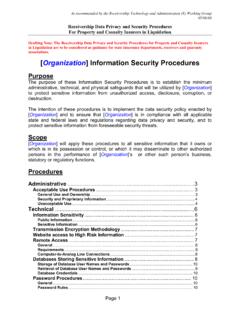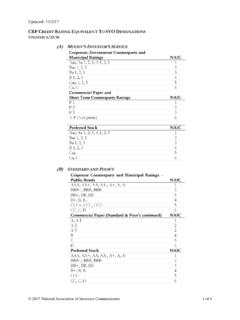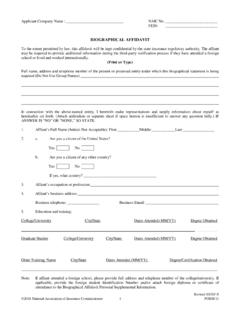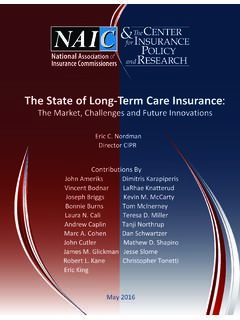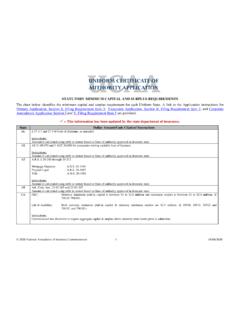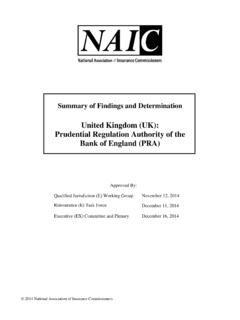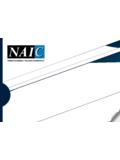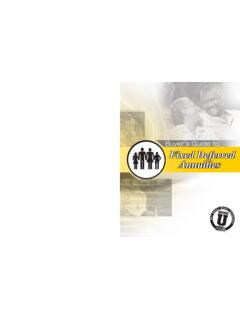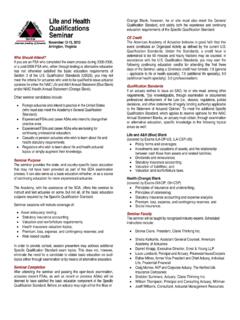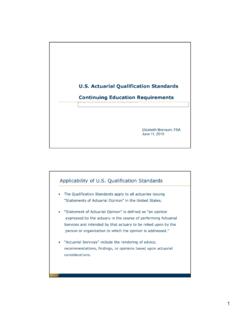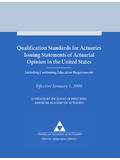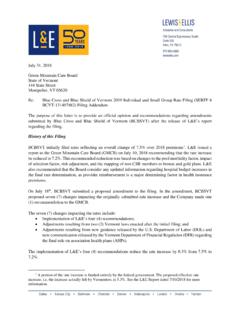Transcription of What are the minimum requirements an actuary should ...
1 March 27, 2015 To: Mike Boerner, Chair, Life Actuarial (A) Task Force National Association of Insurance Commissioners From: Keith Passwater, Chairperson, Committee on Qualifications American Academy of Actuaries Re: FAQ on Qualifications and PBR The National Association of Insurance Commissioners (NAIC) Life Actuarial Task Force (LATF) requested assistance from the American Academy of Actuaries 1 Committee on Qualifications (COQ) with two items: Recommend to the Principle-Based Reserving (PBR) Implementation (EX) Task Force whether to require actuarial certification for each actuarial responsibility in PBR, and Determine whether specific continuing education requirements should be established for PBR actuaries and whether those should be regulatory requirements or actuarial professional requirements . In response to the LAFT request, the COQ undertook a careful review of the.
2 qualification standards (USQS) and determined that the USQS already addresses PBR qualifications albeit in a generalized manner applicable to any new regulations involving Statements of Actuarial Opinion. With the goal of providing as much guidance under the USQS as possible to LATF and credentialed actuaries, the COQ considered how best to communicate the requirements for actuaries issuing Statements of Actuarial Opinion that include PBR. Therefore, the COQ has drafted and intends to publish the following guidance, in the form of a frequently asked question (FAQ) to be posted with other qualification questions and answers on the Academy website: What are the minimum requirements an actuary should consider to be qualified to render opinions related to PBR under the qualification standards ? A credentialed actuary who issues a Principle-Based Reserves (PBR) Statement of Actuarial Opinion when providing Actuarial Services must satisfy the requirements contained in the 1 The American Academy of Actuaries is an 18,500+ member professional association whose mission is to serve the public and the actuarial profession.
3 The Academy assists public policymakers on all levels by providing leadership, objective expertise, and actuarial advice on risk and financial security issues. The Academy also sets qualification , practice, and professionalism standards for actuaries in the United States. qualification standards (USQS) at Some of the primary requirements that an actuary should consider are listed below: 1) The actuary must first meet the Basic Education and Experience requirements for the primary practice area(s) in which the actuary intends to provide a Statement of Actuarial Opinion (SAO). For instance, if the actuary will be rendering a PBR SAO regarding life insurance, the actuary must be a fully qualified member of an International Actuarial Association (IAA)-member organization, have three years of responsible actuarial experience, and be knowledgeable of the Law applicable to the SAO (See Section of the USQS).
4 Additionally, since this hypothetical opinion regards life insurance, the actuary must have: Attained the highest level designation in the organization that has a life specialty track, which is currently the SOA, and have completed the life specialty track, Attained the highest level designation in an IAA-full member organization and have obtained at least one year of responsible actuarial experience in the life practice area under the review of another actuary qualified to render life insurance SAOs, or Obtained a minimum of three years of responsible actuarial experience under the review of another actuary qualified to render life insurance SAOs. 2) Consistent with Section of the USQS, the actuary must be familiar with the Law applicable to PBR Statements of Actuarial Opinion. Per the Code of Professional Conduct, Law is defined to include statutes, regulations, judicial decisions, and other statements having legally binding authority.
5 Examples of such law pertinent to PBR are the applicable NAIC Valuation Manual and the revised Standard Valuation Law. 3) If the area of practice to which the SAO applies is new to the actuary , then USQS Section 4 must be met. 4) If the SAO involves one of the Specific qualification standards SAOs, namely, the actuary is signing an NAIC Annual Statement opinion, the actuary must meet the requirements of Section 3 of the USQS as well. Section regarding the NAIC annual statement opinion requires actuaries to have a minimum of 15 CE hours on topics related to the NAIC annual statement opinion, which in the case of life includes in Section .. (f) valuation and nonforfeiture laws, and therefore requires CE on the PBR valuation law, among other things. 5) Per USQS Section , actuaries must remain current in relevant, emerging advancements in actuarial practice and science that are relevant to the Actuarial Services (as defined in the Code of Professional Conduct) they provide.
6 This section involves keeping up to date on continuing education relevant to an actuary s practice. In the case of PBR, a sample of source material for those advancements is listed on the Academy website ( ). As of March 2015, that list included the following: a. The Actuarial standards Board s June 2014 exposure draft on principle-based reserves for life products ( ) b. Introduction to the Principle-based Approach (PBA) ( ) c. Modeling Efficiency Resources ( s-model-efficiency-work-group) d. PBA Practice Notes: i. Asset Adequacy Analysis practice note exposure draft (August 2014) ii. Life Principle-Based Reserved Under VM-20 practice note exposure draft (February 2014) iii. Practice Note and addendum on the Application of C3 Phase II and Actuarial Guideline 43 (March 2011) iv. Scenario and Cell Model Reduction Practice Note by the Modeling Efficiency Work Group (September 2010) v. C3 Phase III Practice Note by the Life Reserves and Capital Practice Note Work Group (December 2009) e.
7 Economic Scenario Generators ( ) If you have any questions or would like to discuss this information further, please contact Sheila J. Kalkunte, Esq., the Academy s assistant general counsel at
